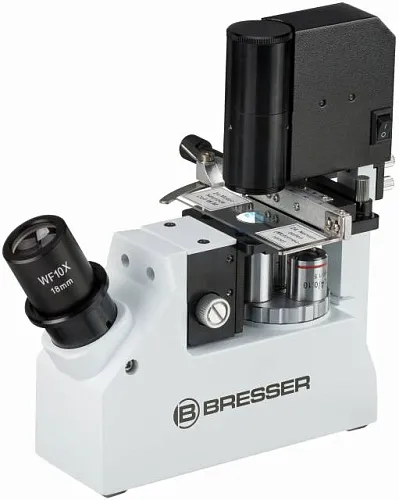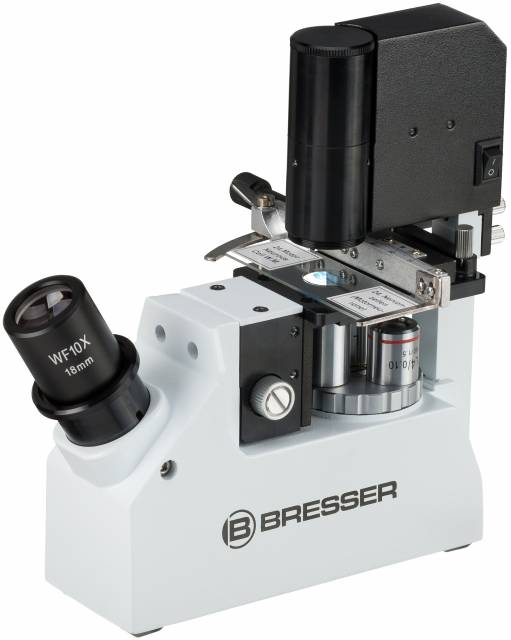Bresser Science XPD-101 Expedition Microscope
Compact, inverted expedition microscope with phase contrast
| Product ID | 75731 |
| Brand | Bresser GmbH, Germany |
| Warranty | 2 years |
| EAN | 4007922039107 |
| Package size (LxWxH) | 23x25x15 cm |
| Shipping Weight | 1.5 kg |
The Bresser XPD-101 expedition microscope is an extremely compact microscope with phase contrast. It comes with 3 standard magnifications 40x; 100x; 400x. For convenient transport, e.g. in hand luggage, the illumination and the crosstable can be disassembled without tools. It is therefore ideally suited for biological or medical field research and can always be on hand when travelling. Due to the inverted design with phase contrast it is perfect for the investigation of plankton or cell cultures. Standard slides can be used instead of special plankton chambers which makes it easy to use and keep costs low.
The microscope is suitable for numerous fields of application, whenever a microscopic analysis on site is required:
- Plankton research in water biology
- Cell cultures in microbiology and life science
- Parasite checks in veterinary medicine, aquaristics or fish farming
- Quality control of phytoplankton or live feed, e.g. in aquaculture or mariculture
- Due to the compact design, the microscope can be used hand held. For longer examinations it is recommended to mount the microscope on a table tripod or with a table clamp using the photo tripod thread in the base plate.
The LED illumination has a built-in, adjustable phase contrast device for the 40x objective. With the 4x and 10x objective an enhanced contrast is achieved, which can be compared to conventional darkfield. For the illumination 2 batteries (1.5V Alkaline Mignon / type AA) are necessary (batteries not included).
Whenever necessary, the microscope can also be used without the LED illumination. Simple remove the housing and use it with bright ambient light as a conventional bright field microscope. This makes the instrument especially versatile and reliable in off-the-grid locations.
For the use of an optional MicroCam the Bresser Reduction Lens 0.5x is required.
The kit includes:
- Monocular inverted microscope; McArthur type with phase contrast
- WF 10x eyepiece, plug-in dimension 23.2mm)
- 3 long working distance planachromatic objectives (LPL4x, LPL10x, LPL40x Ph)
- optical length 160mm, suitable for slides or vessels with 1.2-1.5mm thickness
- mechanical cross table included
- LED illumination with integrated condenser and phase contrast
- Illumination and cross table can be assembled without tools
| Product ID | 75731 |
| Brand | Bresser GmbH, Germany |
| Warranty | 2 years |
| EAN | 4007922039107 |
| Package size (LxWxH) | 23x25x15 cm |
| Shipping Weight | 1.5 kg |
| Head | monocular |
| Magnification, x | 40 — 400 |
| Objectives | 4x, 10x, 40x |
| Body | metal |
| Illumination | LED |
| Power supply: batteries/built-in battery | 2 AA batteries (not included) |
| User level | experienced users, professionals |
| Application | laboratory/medical |
We have gathered answers to the most frequently asked questions to help you sort things out
Find out why studying eyes under a microscope is entertaining; how insects’ and arachnids’ eyes differ and what the best way is to observe such an interesting specimen
Read this review to learn how to observe human hair, what different hair looks like under a microscope and what magnification is required for observations
Learn what a numerical aperture is and how to choose a suitable objective lens for your microscope here
Learn what a spider looks like under microscope, when the best time is to take photos of it, how to study it properly at magnification and more interesting facts about observing insects and arachnids
This review for beginner explorers of the micro world introduces you to the optical, illuminating and mechanical parts of a microscope and their functions
Short article about Paramecium caudatum - a microorganism that is interesting to observe through any microscope

 BE
BE  BG
BG  BY
BY  CY
CY  CZ
CZ  DE
DE  EE
EE  ES
ES  GR
GR  HU
HU  IS
IS  IT
IT  LT
LT  LV
LV  MY
MY  PL
PL  PT
PT  RO
RO  RU
RU  SK
SK  TR
TR  UA
UA  USA
USA 








